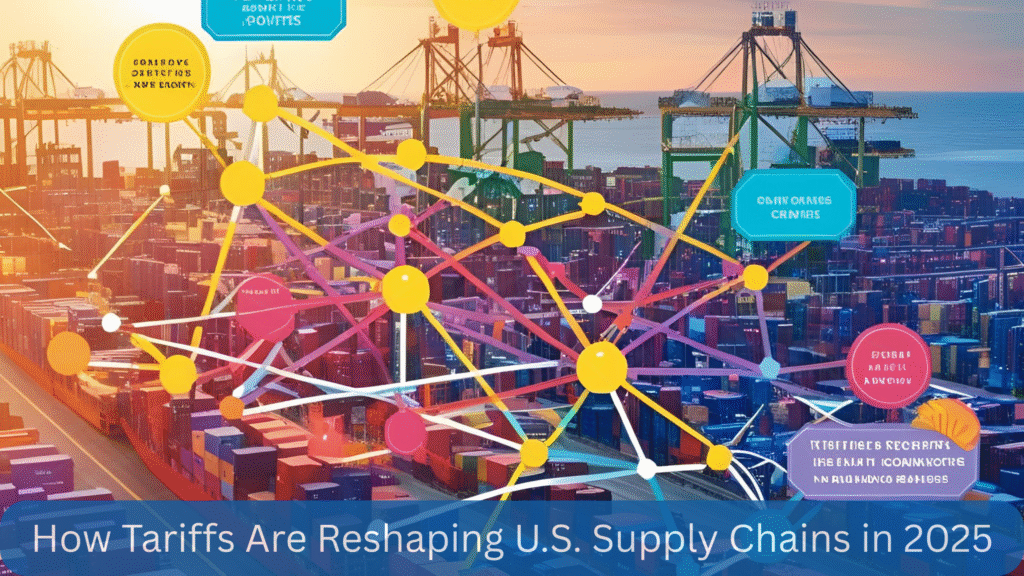The 2025 U.S. tariff regime, characterized by sweeping duties on imports and retaliatory measures from trading partners, has triggered a seismic shift in global supply chains. From automotive to pharmaceuticals, industries are scrambling to adapt to rising costs, policy uncertainty, and the need for strategic agility. Below, we analyze key trends reshaping supply networks and their implications.

1. Automotive: Shifting Production to Avoid 25% Parts Tariffs*
The 25% tariff on imported auto parts (engines, transmissions, EV batteries) has forced manufacturers to rethink decades-old supply chains. Japanese suppliers like Denso and Aisin are accelerating production in Mexico and the U.S. to comply with USMCA rules, reducing reliance on Japan. For example:
- A Tennessee-based Nissan plant cut costs by sourcing transmissions from Silao, Mexico, saving 18% compared to Japanese imports .
- Classic car parts (pre-2000) are exempt, driving a 45% surge in demand for vintage engines like the Nissan SR20DET .
Impact: U.S. automakers are prioritizing nearshoring, but face challenges like retooling factories and requalifying suppliers under FDA/EPA guidelines.
2. Pharmaceuticals: Rising API Costs and Diversification
Tariffs of 20–25% on active pharmaceutical ingredients (APIs) from China and India have disrupted generic drug production. With 70% of U.S. generics relying on Chinese APIs, companies like Teva and Cipla are:
- Exploring suppliers in Eastern Europe and Latin America .
- Investing in FDA-compliant facilities in South Korea and Ireland for biologics .
Consequences: Drug prices for antibiotics and painkillers are rising 12–20%, threatening access for low-income patients .
3. Electronics: Semiconductors Exempt, but Finished Goods Hit
A 10% baseline tariff applies to most electronics, but raw semiconductors are exempt. However, finished products (smartphones, laptops) face duties, creating classification chaos:
- A chip imported as a component avoids tariffs, but once embedded in a phone, the device is taxed .
- Companies like Apple and Samsung are relocating assembly to Mexico and India to reduce exposure .
Result: Supply chain complexity is driving demand for tariff compliance experts to optimize HTS codes and sourcing routes .
4. Steel and Aluminum: Price Surges and Retaliatory Measures
Reinstated 25% tariffs on steel/aluminum have doubled Midwest aluminum premiums to $990/metric ton since January 2025 . Industries like packaging and automotive are responding by:
- Reshoring: Hyundai is building a $5.8B steel plant in Louisiana .
- Diversifying: Alcoa reroutes Canadian aluminum to Europe and sources from India/Middle East .
Fallout: Retaliatory EU tariffs on $21B of U.S. goods (maize, motorcycles) and China’s 125% duties on soybeans are escalating trade wars .
5. Consumer Goods and Retail: De Minimis Rule Changes
The elimination of de minimis exemptions for Chinese goods under $800 means:
- Small importers face formal entry fees ($32.71 minimum) and delays .
- Retailers like Lululemon are shifting textile production to India (26% tariff) and Bangladesh (37%) .
Adaptation: Brands are stockpiling inventory and renegotiating contracts with suppliers for bulk discounts .
6. Policy-Driven Opportunities and Risks
- USMCA Compliance: Auto and pharma firms are prioritizing Mexico/Canada for tariff-free access, but face strict “melted and poured” metal standards .
- Strategic Stockpiling: Companies are securing 1–2 months of critical components (e.g., APIs, semiconductors) to buffer against delays .
- Tech-Driven Agility: AI tools model tariff impacts, optimize HTS codes, and identify dual-sourcing hubs .
Conclusion: The New Era of Supply Chain Resilience
Tariffs have accelerated a structural shift from globalization to regionalization. Companies that thrive will:
- Diversify Sourcing: Adopt “China+2” strategies to mitigate single-country risks .
- Leverage Data: Use predictive analytics to anticipate policy shifts and reprice contracts .
- Invest Locally: Reshore production for critical goods (e.g., EVs, APIs) to access subsidies and avoid duties .
While tariffs strain margins and inflate consumer prices, they also catalyze innovation in logistics, supplier partnerships, and policy compliance—redefining resilience in a fragmented trade landscape.
Key Resources: